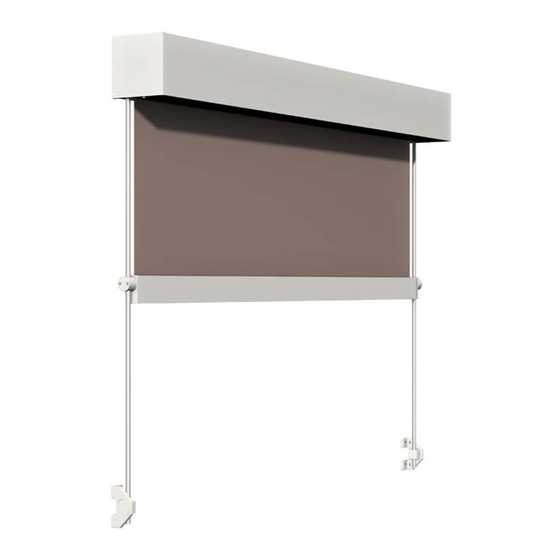
Table of Contents
Advertisement
Quick Links
Advertisement
Table of Contents

Summary of Contents for BAT Screeny 130 Series
- Page 1 Instruction manual Screeny 130 Line...
-
Page 2: Table Of Contents
Contents INTRODUCTION ....................... 3 1.1 - Symbols used in this manual ........................3 SAFETY ..........................3 2.1 - General Safety Information .......................... 3 2.2 - Safety Devices ............................. 4 2.3 - Residual Risks .............................. 4 DESCRIPTION OF THE AWNING ..................4 3.1 - Components .............................. -
Page 3: Introduction
Screeny 130 Line Instruction manual INTRODUCTION This manual is an integral part of the awning and has been written for its user; it is key to the correct use and maintenance of the product. The pages and content contained within this manual may not be removed, rewritten or modified in any way. This manual must be kept intact in an easily accessible location until the awning is disposed of. -
Page 4: Safety Devices
Screeny 130 Line Instruction manual 2.2 - Safety Devices (OPTIONAL, only on motorised models) WIND SENSOR: automatically closes the awning in the event of strong wind. The set point for the wind sensor (anemometer) operation is recorded during the first-start procedure described in the Installer manual. (OPTIONAL, only on motorised models) RAIN Gauge: automatically closes the awning in the event of prolonged rain. -
Page 5: Intended Use And Installation Location
Screeny 130 Line Instruction manual 3.2 - Intended Use and Installation Location The awning is designed to protect against solar radiation and possibly to limit reverberation in the space below it. The product, once in- stalled, is intended only to perform raising or lowering of the awning fabric to reach the open and closed positions, as well as intermediate positions if required. -
Page 6: Technical Data
Screeny 130 Line Instruction manual 3.3 - Technical Data The weights listed in the tables do not take into account the opening system weight (crank or motor). The weights listed in the tables are based on Screen fabric (535 g/m The weights indicated in the tables have been calculated using the maximum awning dimensions. -
Page 7: Technical Data Plate
Screeny 130 Line Instruction manual 3.4 - Technical Data Plate The Technical Data Plate (A) which lists the details for the manufacturer is generally applied to the inner part of the bottom profile section. The Technical Data Plate (B) which lists the product data and specifications is generally provided with the sales documentation. MANUFACTURER'S FULL NAME + ADDRESS MANUFACTURER'S FULL NAME + ADDRESS See section 3.3... -
Page 8: Use Of The Awning
Screeny 130 Line Instruction manual USE OF THE AWNING Before operating the awning, read Chapter 2 “Safety” and Chapter 3.2 “Intended Use and Installation Location” thoroughly. Ensure there is nobody obstructing or excessively close to the awning's moving parts when opening and closing. -
Page 9: Troubleshooting Table
Screeny 130 Line Instruction manual 6.1 - Troubleshooting Table All safety requirements must be followed in the event of faults or troubleshooting, particularly when troubleshooting or repairing faults in the electrical components, where there is a risk of potentially fatal electrocution. Maintenance on the electrical components must be performed only by qualified technicians. -
Page 10: Cleaning The Awning
Screeny 130 Line Instruction manual 6.2 - Cleaning the awning All maintenance and cleaning operations must be performed with the electrical supply disconnected. Cleaning the awning is essential to protect against the formation of mould due to dust or other material deposited on the fabric; this can be performed by vacuuming up the dust, or using a damp cloth or sponge with warm water. -
Page 11: Extraordinary Maintenance
Screeny 130 Line Instruction manual 6.4 - Extraordinary Maintenance Extraordinary maintenance, to be requested from Technical Support, must be performed every two years. If this is not performed, the warranty shall lapse immediately. All extraordinary maintenance operations must be performed by qualified and trained personnel. Request specialist assistance from Technical Support. - Page 12 BAT S.p.A. Via H.Ford - Z.I. Est 30020 - Noventa di Piave (VE) - Italy Tel +39 0421 65672 Fax +39 0421 659007 info@batgroup.com www.batgroup.com 04 September 2013_rev.02...





Need help?
Do you have a question about the Screeny 130 Series and is the answer not in the manual?
Questions and answers